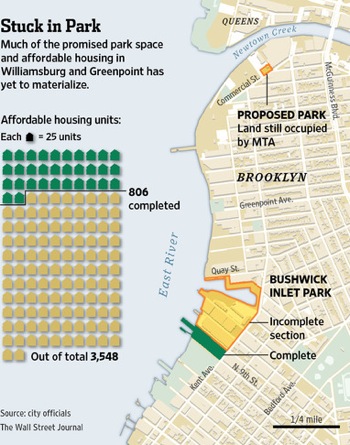As the Brooklyn Paper reports, the Bloomberg administration has refused to commit to any goals or deliverables on the acquisition or construction of Bushwick Inlet Park or 65 Commercial Street. (I guess everyone has given up on the expansion of Barge Park?)
Financial mismanagement and planning gaffes have also stood in the way of both planned open spaces.
Bloomberg officials originally valued [the soccer field block] on the southern edge of the 28-acre Bushwick Inlet Park at about $12 million, but a judge ruled that the area’s residential rezoning meant its value was almost eight times higher.
The city eventually settled with the property owner and bought the parcel for about $93 million, according to court papers and Council testimony…
Money to build a park at Commercial Street dried up too.
In 2007, city budget hawks removed $13 million of the $14 million allocated to the park’s development and spent it on other projects.
Contrary to the headline, I don’t think anyone expects that this administration will finish either of these parks before January, 2014. But the administration can ensure that the parks will be built someday by negotiating contracts to buy all of the Bushwick Inlet properties and by moving the MTA off the Commercial Street lot once and for all.
Neither of those actions will ensure that the parks are completed anytime soon (as I said elsewhere, we are looking at decades), but they will ensure that North Brooklyn has a clear path to getting the parks we were promised seven years ago.


